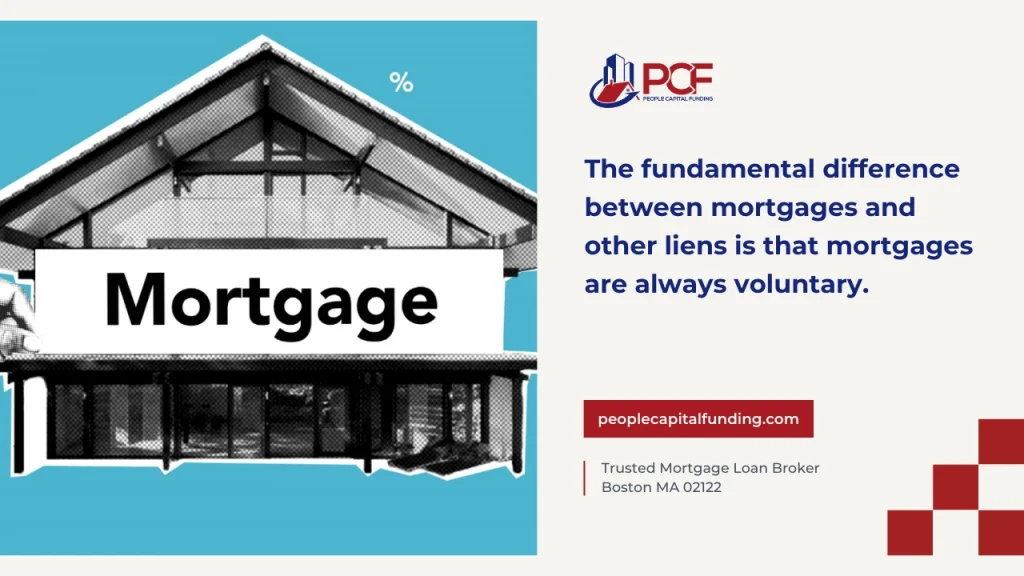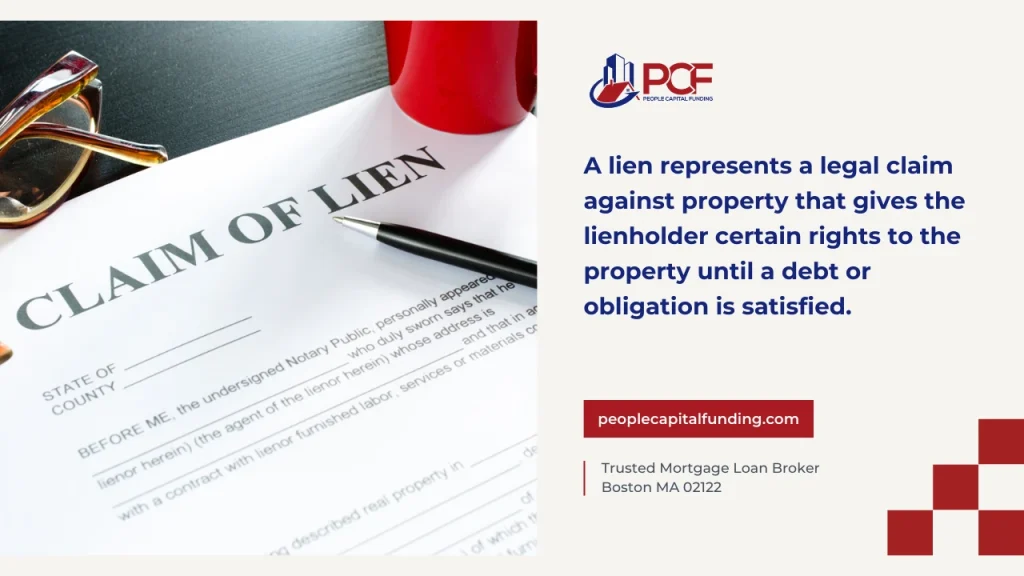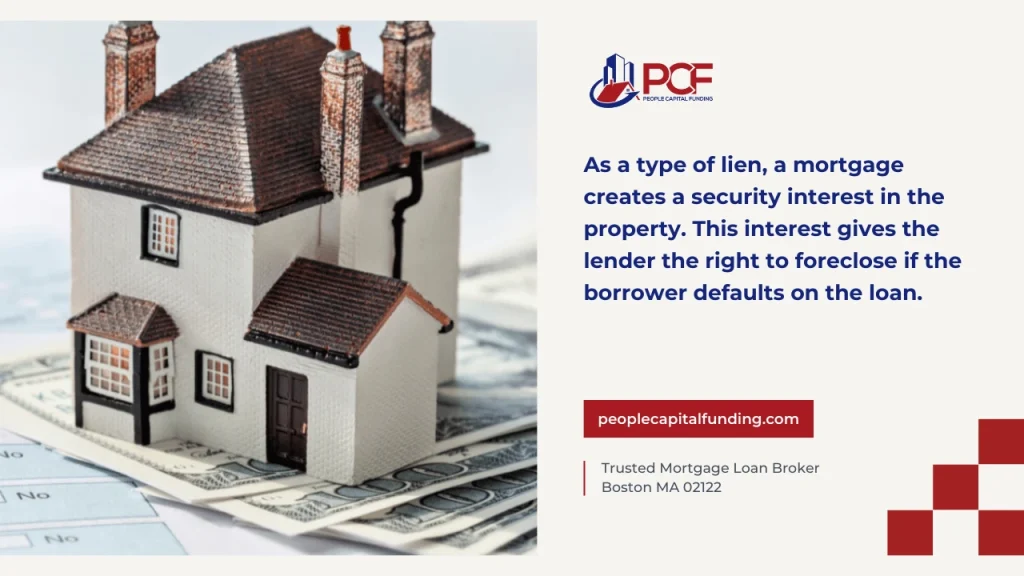
A lien is a legal claim against a property that serves as security for a debt or obligation, while a mortgage is a specific type of voluntary lien created when you borrow money to purchase property. Though related, these concepts have distinct implications for homeowners and homebuyers alike.
Liens vs. Mortages – Detailed Comparison
Scope and Purpose Distinctions
| Aspect | Liens | Mortgages |
|---|---|---|
| Scope | Can apply to any type of property (real, personal) | Apply specifically to real estate |
| Purpose | Secure various types of debts or obligations | Specifically secure real estate financing |
| Origin | Can arise from many situations (unpaid bills, judgments, etc.) | Created specifically for property financing |
| Specificity | May be specific or general | Always specific to the property being financed |
Voluntary vs. Potentially Involuntary Nature
The most fundamental difference between mortgages and other liens is that mortgages are always voluntary. The property owner knowingly agrees to the mortgage as part of the financing arrangement for purchasing the property.
In contrast, many other types of liens are involuntary, placed on property without the owner’s consent as a consequence of unpaid debts or legal obligations. This distinction affects how the lien is created, how it can be resolved, and the relationship between the property owner and the lienholder.

Creation Process Differences
Mortgages follow a standardized creation process:
- Application and approval for financing
- Property appraisal
- Execution of mortgage documents
- Recording of the mortgage with county records
- Funding of the loan
Other liens are created through varying processes:
- Tax liens arise automatically when taxes remain unpaid beyond deadlines
- Judgment liens result from court proceedings
- Mechanics liens require filing by contractors according to state-specific procedures
Rights and Responsibilities Under Each
With mortgages, both parties have clearly defined rights and responsibilities:
- Lenders must follow specific procedures for notices, payment processing, and foreclosure
- Borrowers have obligations to make payments, maintain the property, and keep required insurance
With other liens, the relationship may be less structured:
- Lienholders may have different remedies available depending on lien type
- Property owners might have fewer protections against foreclosure or forced sale
- Priority among multiple liens follows different rules than mortgage priority
What Is a Lien?
A lien represents a legal claim against property that gives the lienholder certain rights to the property until a debt or obligation is satisfied. It serves as security, allowing the creditor to potentially force the sale of the property to recover what they’re owed if the debtor fails to fulfill their obligations.
In practical terms, a lien creates an encumbrance on the property title that can restrict the owner’s ability to sell or refinance until the lien is resolved. Liens exist to protect the interests of those who are owed money in connection with the property.
How Liens Work as Legal Claims
When a lien is placed on a property, it doesn’t transfer ownership. Instead, it establishes a legal interest in the property that remains until the underlying debt is paid or otherwise resolved. The lienholder can’t simply take possession of the property but may have the right to force a sale through legal proceedings like foreclosure.
Liens are typically recorded with county records offices, making them public information that appears during title searches. This public recording serves as notice to potential buyers or lenders that the property has existing claims against it.

Different Types of Liens
Liens come in several forms, each with different characteristics and implications:
Voluntary vs. Involuntary Liens
- Voluntary liens are created with the property owner’s consent. Examples include mortgages and home equity lines of credit.
- Involuntary liens are imposed without the owner’s consent, typically as a result of unpaid debts or legal judgments. These include tax liens, judgment liens, and mechanics liens.
Specific vs. General Liens
- Specific liens attach to particular properties. A mortgage is a specific lien because it applies only to the property being financed.
- General liens apply to all properties owned by the debtor within the jurisdiction. Some judgment liens fall into this category.
Common Examples of Liens
- Tax Liens: Placed by government entities for unpaid property taxes or income taxes
- Judgment Liens: Resulting from court judgments where the property owner owes money to a plaintiff
- Mechanics Liens: Filed by contractors or suppliers who provided labor or materials for property improvements but weren’t paid
- HOA Liens: Placed by homeowners associations for unpaid dues or assessments
- Child Support Liens: Imposed for unpaid child support obligations
What Is a Mortgage?
A mortgage is a specific type of voluntary lien created when you borrow money to purchase real estate. It’s a legal agreement between a borrower and a lender where the property serves as collateral for the loan. If the borrower fails to make payments as agreed, the lender can foreclose on the property to recover the loan balance.
Unlike some other liens, a mortgage is intentionally created by the property owner as part of a financing arrangement. The mortgage gives the lender security for the substantial sum typically required to purchase real estate.
How Mortgages Function as Specific Types of Liens
As a type of lien, a mortgage creates a security interest in the property. This interest gives the lender the right to foreclose if the borrower defaults on the loan. However, mortgages are distinguished from other liens by their voluntary nature and specific purpose of financing the purchase of the property itself or leveraging existing property value.
In the context of property ownership, the mortgage represents a consensual encumbrance that the homeowner accepts in exchange for the financial resources needed to acquire the property.

Key Components of a Mortgage Agreement
A typical mortgage includes several important elements:
- Principal: The original amount borrowed
- Interest rate: The cost of borrowing, expressed as a percentage
- Term: The length of time for repayment, commonly 15 or 30 years
- Payment schedule: The frequency and amount of required payments
- Security clause: The provision that allows the lender to foreclose if payments aren’t made
- Acceleration clause: Allows the lender to demand full payment if certain conditions occur
- Escrow requirements: Provisions for property tax and insurance payments
Common Mortgage Structures in the U.S. Housing Market
The American housing market offers various mortgage structures to meet different needs:
- Conventional mortgages: Traditional loans not insured by the federal government
- FHA loans: Insured by the Federal Housing Administration, featuring lower down payment requirements
- VA loans: Available to veterans and service members, often requiring no down payment
- USDA loans: Designed for rural homebuyers, offering favorable terms
- Fixed-rate mortgages: Interest rates remain constant throughout the loan term
- Adjustable-rate mortgages (ARMs): Interest rates can change based on market conditions
- Interest-only mortgages: Allow payment of just interest for an initial period
- Balloon mortgages: Require a large final payment after a series of smaller payments
How Liens Can Affect Your Mortgage Application
Impact of Existing Liens on Property Purchase
When you’re buying property, existing liens can significantly complicate the process. Most lenders require “clear title” before approving a mortgage, meaning all existing liens must be addressed. During the purchase process, title companies perform searches to identify existing liens that could interfere with your ownership rights.
If liens are discovered, they typically must be resolved before closing can occur. This might involve:
- The seller paying off the debt that created the lien
- Negotiating a settlement with the lienholder
- Establishing escrow accounts to handle outstanding claims
- In some cases, adjusting the purchase price to account for the lien amount
How Lenders View Different Types of Liens
Mortgage lenders evaluate property liens carefully during the underwriting process. Their concerns vary based on lien type:
- Tax liens are particularly problematic because they often take priority over other claims, including mortgages
- Judgment liens against the property seller may indicate financial distress that could complicate the transaction
- Mechanics liens might suggest unresolved disputes about property improvements
- Liens against the buyer (even on other properties) can affect credit scores and debt-to-income ratios
Strategies for Dealing with Liens During the Home Buying Process
Discovering liens on a potential property purchase requires strategic action rather than panic. Smart buyers can navigate these situations with these approaches:
- Conduct early title research: Identify potential lien issues before you’re emotionally invested in the property
- Require escrow hold-backs: If liens can’t be resolved before closing, negotiate for funds to be held in escrow until resolution
- Subordination agreements: For certain liens, creditors may agree to take secondary position behind your new mortgage
- Seller financing consideration: In complicated lien situations, seller financing might offer flexibility that conventional lenders can’t provide
- Lien bond purchase: In some jurisdictions, you can purchase a bond that essentially guarantees payment to lienholders while allowing the sale to proceed
- Conditional loan approval: Work with your mortgage broker to secure conditional approval pending lien resolution

The approach that works best depends on the specific lien type, dollar amount, and your leverage in the transaction. Being prepared with multiple strategies gives you negotiating power when addressing these challenges.
Best Practices to Manage Liens and Mortgages
Preventing Unwanted Liens on Your Property
Taking proactive steps can help homeowners avoid unwanted liens:
- Pay bills promptly: Timely payment of taxes, contractor invoices, and other obligations prevents most involuntary liens
- Obtain lien waivers: When having work done on your property, request lien waivers from contractors and subcontractors as payments are made
- Address disputes quickly: Don’t ignore billing disagreements, as unresolved disputes can escalate to liens
- Keep detailed records: Maintain documentation of all property-related payments
- Monitor your credit: Regular credit checks can alert you to potential judgment creditors
- Consider homestead protection: In some states, homestead declarations provide additional protection against certain liens
Lien Priority – What It Means for Homeowners
Lien priority establishes a hierarchy determining which creditors get paid first from property sale proceeds. This pecking order has significant implications for homeowners:
- The general rule of “first recorded, first paid” applies in many situations
- Statutory liens (especially tax liens) often jump to the front of the line, regardless of when they were recorded
- Primary mortgages usually maintain priority over secondary financing or home equity loans
- HOA liens in some states can gain “super priority” status over earlier recorded mortgages
This priority structure creates practical consequences for property owners. For example, falling behind on property taxes could trigger foreclosure proceedings even if your mortgage payments are perfect, since tax authorities often hold a priority position. Similarly, if you have multiple mortgages or equity lines, understanding their relative positions helps you make strategic decisions about which to pay off first when financial resources are limited.
How to Remove Liens from Your Property
Removing existing liens typically involves one of these approaches:
- Pay the debt: The most straightforward way to remove a lien is to pay what’s owed
- Negotiate a settlement: Sometimes lienholders will accept less than the full amount, especially for older debts
- Dispute inaccurate liens: If a lien was filed incorrectly, you can petition for its removal
- Wait out statutory limits: Some liens expire after a certain period, though this varies by state and lien type
- Seek court intervention: In some cases, a court order can remove inappropriate liens
- Bankruptcy: In certain circumstances, bankruptcy can clear some types of liens
Conclusion
A mortgage represents just one type of lien, specifically, a voluntary one created for property financing. Other liens emerge from various obligations and operate under different rules regarding their creation, priority, and resolution.
When liens appear during property transactions, having a current title report and documentation related to any existing claims provides clarity. Property transactions involve significant investment, and taking time to understand these legal mechanisms helps protect that investment for years to come.
